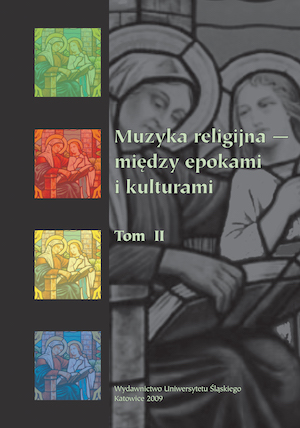Nabożeństwa majowe przy kapliczkach i krzyżach przydrożnych
Marian prayers by the crosses and roadside chapels as a form of the Catholic folk piety
Author(s): Jacek Jackowski
Subject(s): Music
Published by: Wydawnictwo Uniwersytetu Śląskiego
Summary/Abstract: May is the time of beautiful Marian services, the aim of which is a common performanceof Litania loterańska and Marian songs, sung not only in churches, but also by road crossesand chapels. The tradition of folk Marian prayers, commonly referred to as “May services”, isslowly disappearing, though, it is one of few forms of folk piety Church officially recommendsand advocates.In Western Church, the first evidence of May being devoted to the Mother of God comesfrom the end of the 16th century. May prayers, whose cradle was probably Italy, were popularisedat the turn of the 18th and 19th centuries in western Europe, i. e. in Spain, France, Germanyand Austria. In 1815, Pius VII the Pope accepted the prayer in question and providedit with indulgence. May prayer was instilled in Poland by Jesuits in the 19th century, in thebeginning in the environment of schools and teenagers in Gallicia, and subsequently, it becamepopular in many churches, not only monastic ones.In a temple, the May prayer is celebrated in front of the exposition of the Blessed Sacramentwith the priest’s engagement. The whole prayer is usually sung. Singing constitutes itsmain element. It is Litania loterańska after which the Marian song follows as well as considerationsreferring to the Marian theology.Countries situated far from parish churches have strengthened the tradition of the so called“May prayers” conducted by the congregation by the cross or chapel where the veryprayer is usually performed without the priest’s presence. It is difficult to say why May prayershave gained such a big popularity among people. The assumption is that “May prayers”replaced old folk traditions of a secular nature connected with spring celebration, and assimilatedby church imposing new Christian symbolic meanings on them. On the other hand,popularity of the prayers under discussion could be ascribed to a strong involvement of manorhouses. May prayers constitute the expression of folk piety, and although they are deprivedof liturgical celebrations, they emanate with fierce and sincere prayer.
Book: Muzyka religijna – między epokami i kulturami. T. 2
- Page Range: 260-277
- Page Count: 18
- Publication Year: 2009
- Language: Polish
- Content File-PDF

